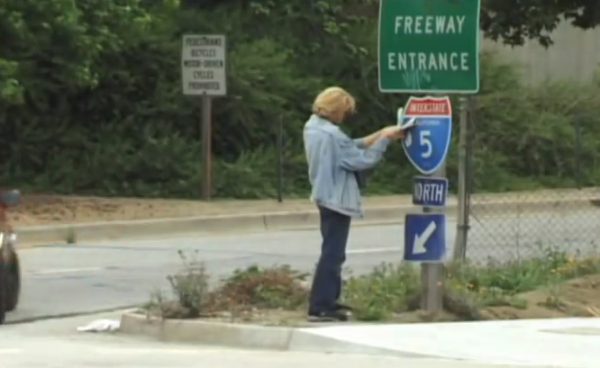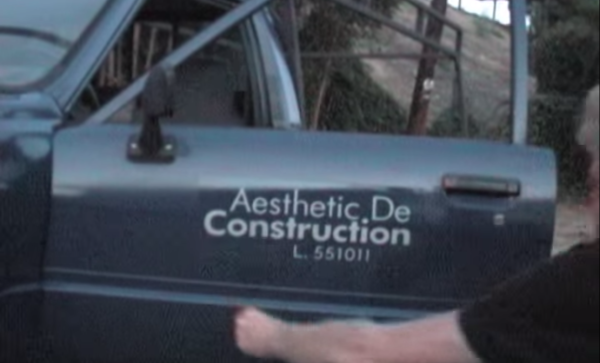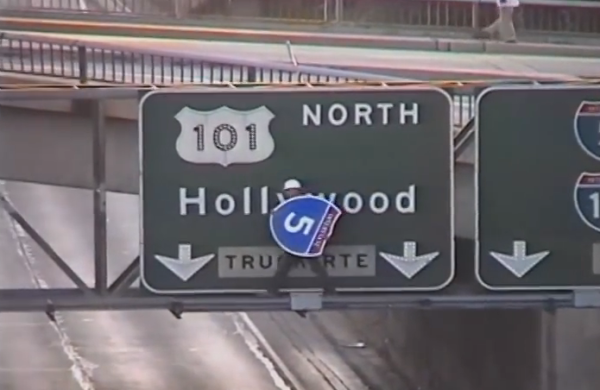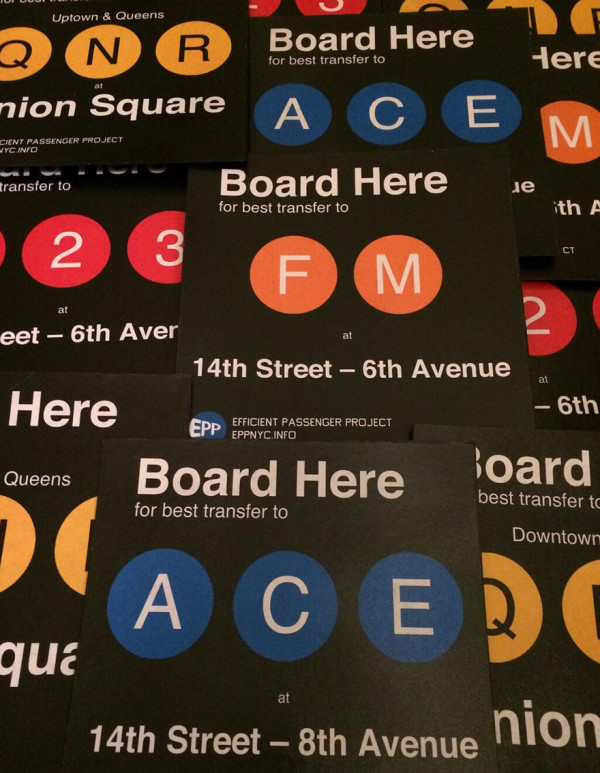At some point in your life, you’ve probably encountered a problem in the built world where the fix was obvious to you. Maybe a door that opened the wrong way, or a poorly painted marker on the road. Mostly, when we see these things, we grumble on the inside, and then do nothing. But not Richard Ankrom.

In the early morning of August 5, 2001, artist Richard Ankrom and a group of friends assembled on the 4th Street bridge over the 110 freeway in Los Angeles. They had gathered to commit a crime — one Ankrom had plotted for years.
Twenty years earlier, Ankron, then living in Orange County, was driving north on the 110 freeway. As he passed through downtown Los Angeles, he was going to merge onto another freeway, the I-5 North. But he missed the exit and got lost. And for some reason, this stuck with him.

Years later, when Ankrom moved to downtown Los Angeles, he was driving on the same stretch of freeway where he’d gotten lost before. He looked up at the big green rectangular sign suspended above and realized why he missed the exit all those years ago.
The sign was not adequately marked.

The I-5 exit wasn’t indicated on the green overhead sign. It was clear to Ankrom that, the California Department of Transportation (known as Caltrans) had made a mistake.
Ankrom, an artist and sign painter, decided to make the Interstate 5 North shield himself. He also decided that he would take it upon himself to install it above the 110 freeway.
He would call it an act of “guerrilla public service.”

Ankrom started by studying L.A. Freeways signs and holding up pantone swatches to perfectly match the paint color. He dangled over bridges to measure the exact dimensions of other signs.

Most importantly, Ankrom consulted the MUTCD, The Manual on Uniform Traffic Control Devices, which provides “uniform standards and specifications for all official traffic control devices in California.”

Ankrom wanted his sign to be built to the exact specifications of Caltrans, which were designed to be read by motorists traveling at high speeds.
He copied the height and thickness of existing interstate shields, copied their exact typeface, and even sprayed his sign with a thin glaze of overspray of gray house paint so that it wouldn’t look too new.
If he was successful, no one would know that the signs weren’t put up by Caltrans.

As a finishing touch, Ankrom signed his name on the back with a black marker, like a painter signing a canvas.
Then came the next phase of the project: the installation. Ankrom planned it with the precision of a bank heist. He cut his hair, bought some work clothes and a hardhat and an orange vest. He even made a Caltrans contractor-esque decal for his pick-up truck.

He feared he could get arrested, or worse — drop the sign or one of his tools on the cars driving underneath. But he felt it was too late to turn back.

On August 5, 2001, Ankrom parked his truck and went to work. He positioned his ladder over the razor wire and made his way up to the catwalk under the sign, nearly 30 feet above the highway.

The whole installation took less than 30 minutes. As soon as the sign was up, Ankrom packed up his ladder, rushed back to his truck, and blended back into the city.
For about nine months, only a small group of people knew that the Interstate 5 shield hanging above the 110 freeway was a forgery. Then one of Ankrom’s friends leaked the story to a local paper. And that’s how Caltrans found out.

Ankrom had hoped he could get his sign back from Caltrans after they took it down; he figured he would hang it in an art gallery. But Caltrans didn’t take the sign down. His guerrilla sign had passed the Caltrans inspection.

More than eight years after Ankrom’s sign went up, he got a call from a friend who noticed some workers taking it down. His sign was being replaced as part of routine maintenance.
When the new sign went up, however, Caltrans had added the I-5 North shield not only to it, but also to two additional signs up the road.
There is another guerrilla public service project in New York City by a group called the Efficient Passenger Project. The EPP has been hanging signs in subway stations informing people where they should board the train to make the most efficient transfers.

Even though the EPP’s signage has the look and feel of those from the MTA, they are completely unaffiliated. The MTA considers these signs vandalism, and is taking down the signs as fast as they go up — they have also done the same with other guerrilla subway signage.
The point being, if you decide to undertake an act of “guerrilla public service,” just know that it may not be received as such, so proceed with caution and avoid getting caught.’
Coda: Guerrilla Urbanism & Gardening
There are a lot of other fascinating urban interventions out there as well. Some raise awareness, even if they are only temporary, but others (like the L.A. sign project) have had more permanent effects.
In San Francisco, a guerrilla bike lane installed by activists was later made official by the city. A nearby public bench project has been putting up free benches in SF for decades as well. The Bay Area has also been home to a number of guerrilla movie theater initiatives.
Guerrilla urbanism is not just limited to streets and sidewalks, either — guerrilla gardening efforts, including seed bombs and ammunition, have helped spread greenery around cities. Meanwhile, guerrilla grafters have done creative work that questions whether ornamental street trees could also be used to grow fruit and feed hungry citizens.



Comments (46)
Share
My favourite version of this is guerilla bike lanes. Google it.
The new bike lane of Guadalajara:
http://youtu.be/iFUbrme9V0M
In Seoul, the subways lines almost all have transfer guides, and many subway apps also tell you the transfer doors. It’s planned as part of the system. It’s funny that in New York they refuse it.
Hey! You weren’t supposed to see this article me. LA’s my neighborhood.
A good example, from Paris:
http://www.theguardian.com/world/2007/nov/26/france.artnews
What’s the song at the end of the episode singing about the NYC subway?
My My Metrocard – Le Trigre
https://www.youtube.com/watch?v=sT1zzc-hVCY
Le Tigre*
http://www.yankodesign.com/2014/09/17/universal-lost-and-found/
What’s the song played in the background when Roman is describing the installation of the sign? Sounds like such a classic heist movie song that I should totally know.
They’re songs from Amon Tobin’s Supermodified album. It’s a really really great album.
Hi all – I’ve listed the music we used at the end of the post. Most of it was Amon Tobin.
The story never mentions whether Richard ever tried informing CALTRANS of the need for the extra signage (wayfinding). Seems like a logical first step to call, write or email them. If they never respond or act, consider the next step. Perhaps the transportation section of the local newspaper. If all else fails, then maybe it’s time to take matters into one’s own hands for the benefit of the public good.
I tried.
The sign is still “broken”, 10 years later.
The reason the MTA doesn’t like the “Efficient Passenger Project” signs is because of load balance. You can dismiss it all you want, Roman, but if everyone wants to get into the same car to make a popular transfer (say the 4/5/6), then it’ll take longer than it already does to get out of the station. This will delay the whole system, all because some yahoos feel the need to get into ONE car. It’s a fantastic idea, but simply falls apart in the face of the everyday realities of the NYC subway system.
It’s also worth mentioning another approach to gorilla sign management, which as a Bay Area resident, I assume Roman knows about: the sign that indicates the turnoff from Route 1 to Bolinas, CA. Or really, the lack thereof: residents of the town have been taking it down for decades to dissuade people from discovering their little hippy village, to the point where many of them have one of the signs on display at their homes. Eventually, CalTrans stopped replacing it.
There’s a group called Walk Your City that’s been hanging up signs with walking directions, and providing a tool for others to do the same. I’ve come across their signs in San Francisco a couple times recently.
Here’s their website: https://walkyourcity.org/
I read somewhere that Caltrans doesn’t follow the MUTCD but merely uses it as a guideline for their own standards. Is this true? Of course, there was a time when the state had nothing to do with signage. It was the Auto Club that started erecting signs for the benefit of motorists.
Some states have their own version of the MUTCD, CA is one of them . It follows the same basic rules but tailors them to CA needs.
Been working on a similar issue, painting curbs red in front of fire hydrants that weren’t red before. Prevents a lot of people from parking there and getting towed/ticketed.
It’s a more delicate intervention and even more self-consciously an *art* project, but this story reminded me a little of Milena Bonilla’s rather lovely Transitory Map: “I randomly took several bus rides in Bogotá and sew the torn fabric of some of the buses seats. The size of the holes defined the time invested in repairing them while traveling along the city. After each journey, I highlighted the bus’s itinerary by sewing it on a map of the city, using the same thread color as the one used to sew the seat. Twenty-five tours were completed in the project and sixteen are documented.” http://milenabonilla.info/project-128-Transitory_Map.html
Love 99% Invisible.
This was a great show. Thanks for your efforts.
Give the boys a hug and let them know every day you love them. And always back up mom, in front of the kids, even when she’s wrong. United, parents stand, divided, children fall.
My only advice to parents.
The MUTCD is actually a Federal standard that the states adopt. See here here
The Seoul example of the Fast Transfers however is flawed because it revolves around knowing the carriage numbers, and the carriage numbers aren’t marked within the actual carriages. Plus, some of the listed transfers are physically impossible.
Living in Seoul for the last 5 years, fast transfers work because the carriage numbers (more specifically door numbers) are marked in front of every door. Need to transfer at Sadang from line 2 to go downtown? Just enter the train at car 5 door 2 and you’ll be right at the staircase to transfer to the light blue.
I’ve noticed a different example of bad design, but I don’t know what can be done about it. It’s digital buttons on car stereos. With old-time analog buttons, there was one button per function (volume, bass, treble, balance) and each button could go only so far to the left or to the right. The advantage was that you could adjust the sound by touch while you kept your eyes on the road. With those stupid digital buttons, there is one single button for everything, and it goes all the way around. That makes it necessary for you to divert your eyes from the road and look at the stereo screen to check what function you are adjusting and what value it’s at at the moment. This is annoying and dangerous. Somebody please tell car stereo makers to bring back the one button-one function stereo.
Hi Sergio,
The design flaw you describe will probably be short-lived: it’s just a matter of time before all car sound systems will be voice-activated.
I first read about the LA guerrilla sign change in Ken Jennings’ book Maphead. I was delighted to get a more thorough retelling of the story on 99PI! Reminds me of a sign giving directions to the interstate as you are leaving the St. Louis airport. (you can see it here https://www.google.com/maps/@38.741553,-90.368152,3a,75y,122.36h,85.6t/data=!3m4!1e1!3m2!1s05W_rkqAbhYiejnB3BYlpw!2e0 )
The area of the sign that says “To East 70/170” hangs over the right-hand side of the fork in the road, but you actually take the left fork to get to 70/170E. I suppose MODOT thinks that since most of the sign hangs over the left fork, motorists should deduce that everything on the sign applies to the left fork, but I and others have gotten turned around a bunch of times before learning.
Everyone talks a lot about “load balance” when talking about the guerilla NYC board here transfer signs, but I think a bigger issue is information overload. Vignelli’s original designs for the subway system are masterfully simple. It only takes living in the city a little while to really understand how to traverse the subway, which is a major feat. One of the key to this is presentation of information, and I think efficient transfer signs are just overwhelming to people who don’t know how to use the subway and may already be confused. The beauty of the system in place is that presents just enough information to be understood with being utterly confusing.
San Francisco BART system needs this!
The beast does not like your helpful signage…………..
Hi 99pi folks,
Spotted this bit of guerilla public service today and thought you might like to check it out…
http://boingboing.net/2017/07/20/toronto-says-park-stairs-would.html
Cheers for being awesome,
Derek
In the case of the Toronto park stairs, they were poorly built, and of questionable necessity (imagine Ankrom scrawled “I5” on a piece of Bristol board and duct taped it to the overpass sign). I live about a km from the park – virtually no article on the story mentioned how there was a paved path into the park less than 50m away.
But, it shamed the city into building real stairs quickly, so that’s something?
Hi, thought I’d pass on info about something similar in inner city Sydney Australia. There is a small train station called Macdonaldtown. It was very run down and in need of a paint job. The State Rail Authority said it would be very expensive to upgrade the station and would take a long time to do, and questioned whether such a small station was worth the expense. It said that it may be some time before anything could happen. Lots of requests from the local community only resulted in the message that an upgrade would eventually occur.
Then one day commuters woke up to the entire station having been painted bright pink. The guérilla artists then wrote in to Column 9 of the Sydney Morning Herald, the city’s main newspaper – a place where people report funny and whimsical occurrences, and told how a small group completed the project in a few hours having spent less than $50 on paint. It didn’t take long for State rail to jump into action and repaint the station, although most commuters preferred the bright pink!
A good example of where community endeavours haven’t fared so well with local fruit trees: http://mobile.abc.net.au/news/2017-06-02/d-day-arrives-for-more-urban-food-street-grower-residents/8583598?pfmredir=sm
In Australia gardening on public land between the property and street is common practice – but it’s still local council land, and different councils have different regulations. A common requirement is public liability insurance or licences to reduce the council’s liability in case of mishaps, but local councils aren’t always the most transparent or convenient organisations to interact with. This neighbourhood in Buderim, Queensland got in the news recently as the council removed their community nature strip orchards due to the lack of said permits, despite the orchards being there for many years.
It’s not just liberal cities that do this! I was involved in this tactical urbanism project in Provo Utah, where we revamped an entire city block overnight. We created bulbouts, a protected bike lane and provided wayfinding signs. It was awesome! http://www.heraldextra.com/news/local/central/provo/volunteers-work-under-cover-of-darkness-to-reimagine-provo-street/article_41c48c10-f93f-5761-86af-88de2c988c9a.html?utm_medium=social&utm_source=facebook&utm_campaign=user-share
There’s a great app (and site) called SeeClickFix.com that is an increasingly popular way to report everything from design improvement opportunities to missed trash pickups and — my favorite — streetlights that either are on 24/7, or not on at all.
It has been used here in Princeton, NJ, successfully for a number of years.
This is a great thing to see someone taking action like this, but he could’ve killed someone if he dropped that sign on an active freeway. Not sure why he didn’t think of applying vinyl graphics instead of carrying a heavy-ass metal sign onto a freeway overpass. Even traffic on a Sunday morning means there will be some people moving through the freeway. Think before you act people! Stencils or vinyl would’ve looked just as good if you do it well and shouldn’t take any longer to install.
I’ve heard of this happening in other cities also.
Kudos, kinda, but two questions:
1) Why on Earth would he do any field work when everything — colors and dimensions — are detailed exactly in the MUTCD?
2) And why didn’t he /start/ by contacting highway officials to see if they would just fix the sign properly, rather than risk his own safety and that of motorists by doing it himself?
Admirable goals, moronic execution.
This artistic endeavor is legendary was done with expect execution that is indicative of a meticulous creative mind. It is a heart warming reminder of why I have always loved public art in its seemingly infinite forms.
Great episode and reminded me of this Guerrilla clock restoration in Paris
“Undercover restorers fix Paris landmark’s clock” https://www.theguardian.com/world/2007/nov/26/france.artnews?CMP=share_btn_wa
A sane person would contact the relevant authorities about the problem, instead of spending a ridiculous amount of time planning a DIY job (to the point of DELIBERATELY IMPERSONATING AN EMPLOYEE??).
This isn’t inspiring or something worth celebrating, it’s a story of a vain idiot.
Okay, this is awesome. Especially since the sign was up there for nine years!
“His sign was being replaced with as part of routine maintenance.”
Sigh.
There are so many spots that could use a painted cross walk where one doesn’t exist. Any ideas on how to accomplish that? I thought chalk paint, but the result would be crude even if the community did get the message.